Feasible Concept of an Air-Driven Fan with a Tip Turbine for a High-Bypass Propulsion System
Abstract
1. Introduction
2. Principle of the ADFTT and Its Application to the High-Bypass Propulsion System
2.1. Principle and Brief Structure of the ADFTT
2.2. High-Bypass Propulsion System that Adopts the ADFTT
3. Theoretical Thermodynamic Analysis of the ADFTT
3.1. Basic Equilibrium Principles
3.2. Thermodynamic Analysis of the ADFTT Effects
3.3. Engine Performance Estimation of the ADFTT
4. Exploratory Design of the ADFTT
4.1. Top-Level Parameters of the Exploratory Design
- (1)
- The core engine remains at the same performance (same thrust, same fuel consumption).
- (2)
- All the energy transferred to the air of the (additional) bypass is converted into the kinetic energy of the air.
- (3)
- Ignoring the nozzle loss to simplify the calculation.
4.2. Profiles Design of the ADFTT Blades
5. Numerical Verification of the ADFTT Rotor and Discussions
5.1. CFD Method
5.2. CFD Results and Discussions
5.2.1. Tip Turbine
5.2.2. Air-Driving Fan
5.3. Comparison between the Prototype Turbofan and the Demo ADFTT
6. Conclusions
- (1)
- A concept of a turbofan with an ADFTT is presented. This machine can solve the incompatibility problem of the fan and LTP, and is a promising device for high-bypass propulsion systems, especially for cost-controllable and small/mid-size aircraft.
- (2)
- Theoretical thermodynamic analysis of the ADFTT is proposed. The equivalent efficiency is also introduced to evaluate the energy transfer process. The ADFTT significantly improves the bypass of the prototype turbofan and increase the thrust.
- (3)
- An ‘aero-extending’ design can resolve the low solidity problem of the rotor of the tip turbine and ensure the positive performance. The aero-extending blade can extend the blade aerodynamically and achieve the design target of the efficiency.
- (4)
- This research aims to perform the exploratory design of the ADFTT, including the CFD results of the rotor of the ADFTT. The results of the demo work show the potential feasibility of the ADFTT, and further improvements can be expected. In comparison with the prototype turbofan, the performance of the CFD results shows that the ADFTT can improve the thrust by 84.0% and reduce the SFC by 45.6%.
Author Contributions
Funding
Acknowledgments
Conflicts of Interest
References
- Marin, N.; Spataru, P. The role and importance of UAV within the current theaters of operations. INCAS Bull. 2010, 2, 66–74. [Google Scholar]
- Nicolosi, F.; Vecchia, P.D.; Corcione, S. Design and aerodynamic analysis of a twin-engine commuter aircraft. Aerosp. Sci. Technol. 2015, 40, 1–16. [Google Scholar] [CrossRef]
- Zimbrich, R.A.; Colehour, J.L. An investigation of Very High Bypass Ratio Engines for Subsonic Transports. In Proceedings of the Propulsion Specialist Conference, Boston, MA, USA, 11–13 July 1988. Paper No. 88-2953. [Google Scholar]
- Rohrbach, C.; Metzger, F.B.; Black, D.M.; Ladden, R.M. Evaluation of Wind Tunnel Performance Testing of an Advanced 45° Swept Eight-Bladed Propeller at Mach Numbers from 0.45 to 0.85; NASA CR-3505; National Aeronautics and Space Administration: Washington, DC, USA, March 1982.
- DeGeorge, C.; Turberg, J.; Wainauski, H. A Report on the Initial Testing of the Large Scale Advanced Prop-fan. In Proceedings of the 22nd Joint Propulsion Conference, Huntsville, AL, USA, 16–18 June 1986. AIAA Paper 86-1551. [Google Scholar] [CrossRef]
- Larsson, L.; Grönstedt, T.; Kyprianidis, K.G. Conceptual Design and Mission Analysis for a Geared Turbofan and an Open Rotor Configuration. In Proceedings of the ASME 2011 Turbo Expo: Turbine Technical Conference and Exposition, Vancouver, BC, Canada, 6–10 June 2011; pp. 359–370. [Google Scholar]
- Kestner, B.K.; Schutte, J.S.; Gladin, J.C.; Mavris, D.N. Ultra High Bypass Ratio Engine Sizing and Cycle Selection Study for a Subsonic Commercial Aircraft in the N + 2 Timeframe. In Proceedings of the ASME 2011 Turbo Expo: Turbine Technical Conference and Exposition, Vancouver, BC, Canada, 6–10 June 2011; pp. 127–137. [Google Scholar]
- Neitzel, R. Comparisons of alternate energy efficient engines for future subsonic transports as affected by engine technology improvements. In Proceedings of the 12th Propulsion Conference, Palo Alto, CA, USA, 26–29 July 1976. [Google Scholar]
- Kurzke, J. Fundamental Differences Between Conventional and Geared Turbofans. In Proceedings of the ASME Turbo Expo 2009: Power for Land, Sea, and Air, Orlando, FL, USA, 8–12 June 2009; pp. 145–153. [Google Scholar]
- Kutney, J. Aerothermodynamic Considerations of the Tip Turbine Driving Lift/cruise Fan Propulsion System. In Proceedings of the AIAA Summer Meeting, Los Angeles, CA, USA, 17–20 June 1963. [Google Scholar]
- Gleiter, D.P. A Comparison of Two Lift Cruise Fan Propulsion Concepts. In Proceedings of the AIAA Aircraft Systems and Technology Meeting, Dallas, TX, USA, 27–29 September 1976. [Google Scholar]
- Haas, J.E.; Kofskey, M.G.; Hotz, G.M.; Futral, S.M., Jr. Cold-Air Performance of a Tip Turbine Designed to Drive a Lift Fan. I—Baseline Performance; NASA TM X-3452; National Aeronautics and Space Administration: Washington, DC, USA, 1976.
- Hass, J.E.; Kofskey, M.G.; Hotz, G.M. Cold-Air Performance of a Tip Turbine Designed to Drive a Lift Fan. IV—Effect of Reducing Rotor Tip Clearance; NASA TP-1126; National Aeronautics and Space Administration: Washington, DC, USA, 1976.
- Casado, H.; Cristobal, E.; Lorido, A.; Ramsden, K.W. A Tip-Turbine Driven Propulsion Fan Concept. In Proceedings of the ASME Turbo Expo 2002: Power for Land, Sea, and Air, Amsterdam, The Netherlands, 3–6 June 2002; pp. 877–885. [Google Scholar]
- Hatta, H.; Kogo, Y.; Tanatsugu, N.; Mizutani, T.; Ohnabe, H. Application of advanced carbon-carbon composites to a tip turbine structure of the ATREX engine. In Proceedings of the 36th Structures, Structural Dynamics and Materials Conference, Boston, MA, USA, 30 June 1997. [Google Scholar]
- Huang, G.P.; Xiang, X.; Chen, J.; Chen, X.; Lu, W.Y. High Bypass Ratio Turbofan Engine with Air-Driven Fan. Chinese Patent NO:2014108237250, 8 October 2014. [Google Scholar]
- Hu, X.Y. World Handbook of Small and Medium Aero Engines; Aviation Industry Press: Beijing, China, 2006. [Google Scholar]
- Asmus, F.J. Design and development of the tip turbine lift fan. Ann. N. Y. Acad. Sci. 2010, 10, 147–176. [Google Scholar] [CrossRef]
- Gallimore, S.J. Axial Flow Compressor Design. Proc. Inst. Mech. Eng. 1999, 213, 437–449. [Google Scholar] [CrossRef]
- Glassman, A.J. Turbine Design and Application; NASA SP-290; NASA Special Publication: Washington, DC, USA, 1972; p. 290. [Google Scholar]
- Spalart, P.; Allmaras, S. A one-equation turbulence model for aerodynamic flows. La Recherche Aerospatiale 1994, 1, 5–21. [Google Scholar]
- Zhang, J.; Zhou, Z.; Wei, W.; Deng, Y. Aerodynamic design of an ultra-low rotating speed geared fan. Aerosp. Sci. Technol. 2017, 63, 73–81. [Google Scholar] [CrossRef]
- Shepherd, D.G. Principles of Turbomachinery. Macmillan 1956. [Google Scholar] [CrossRef][Green Version]
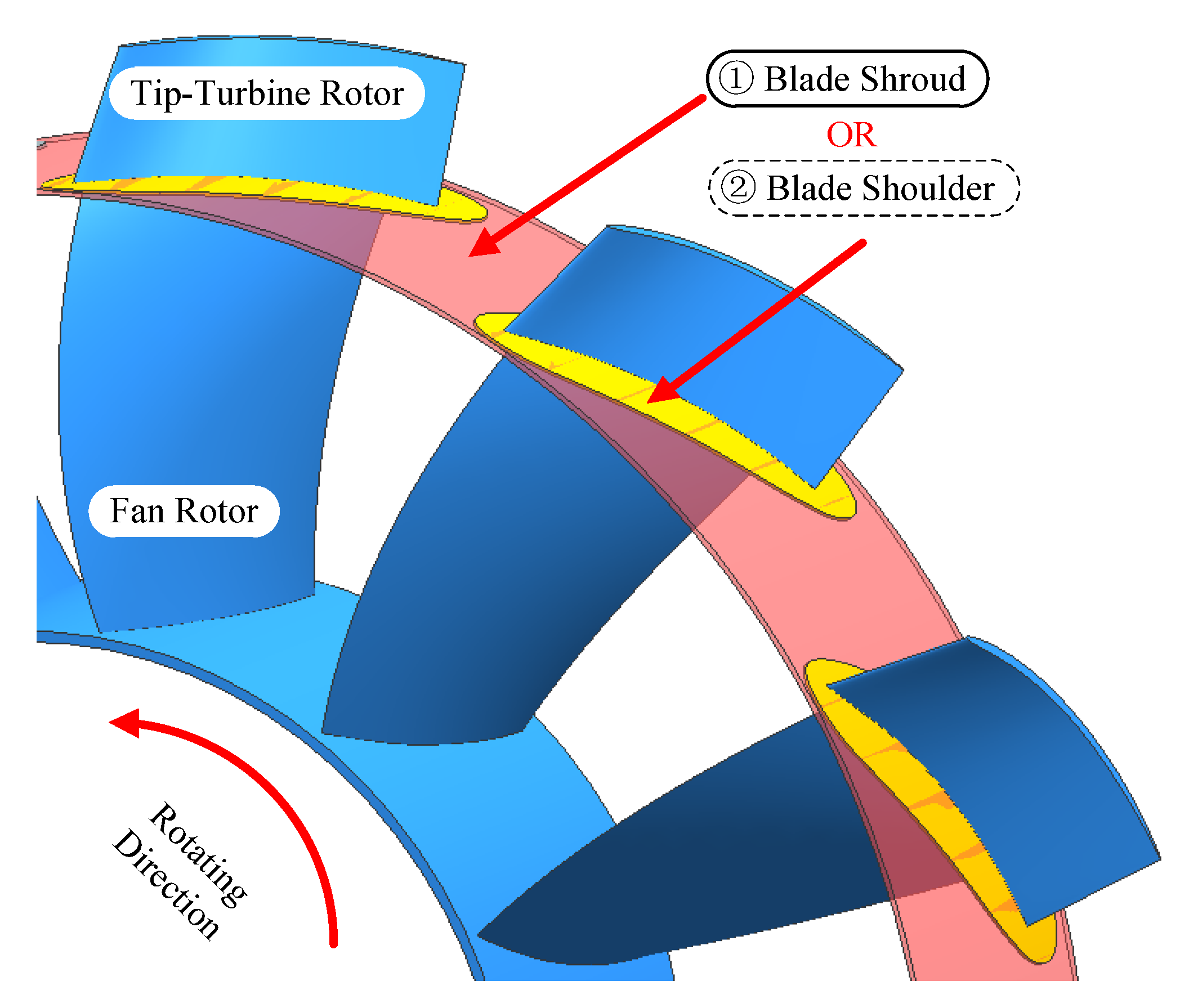

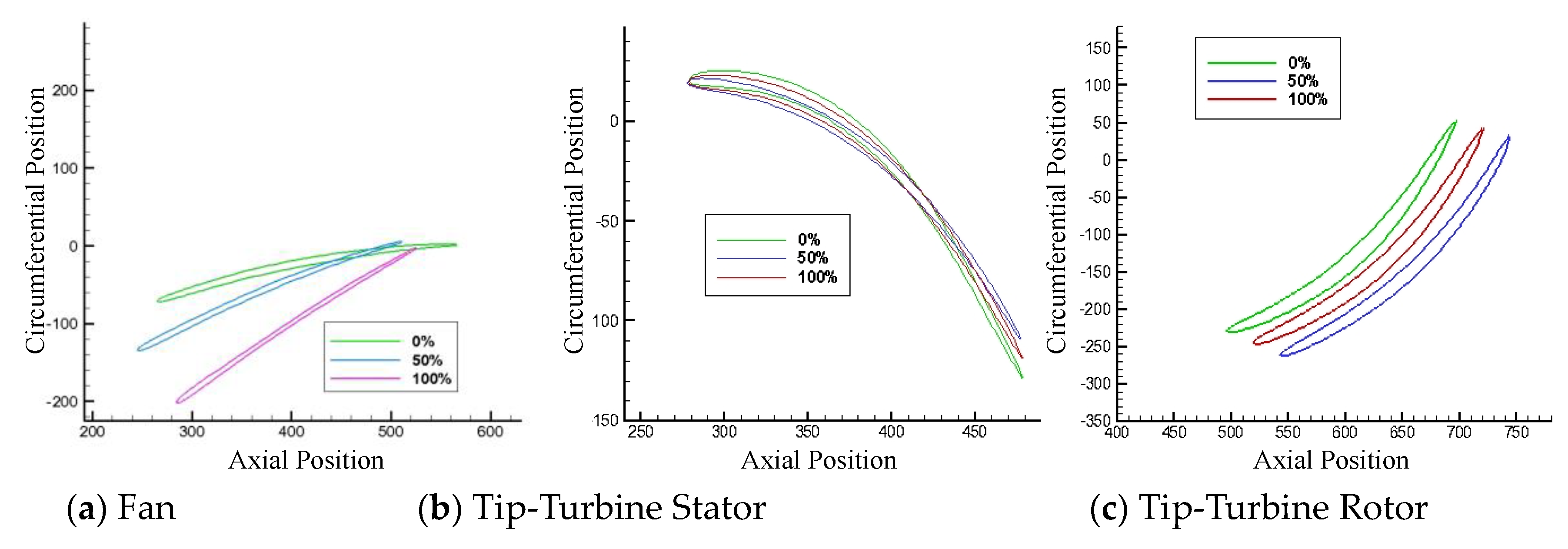
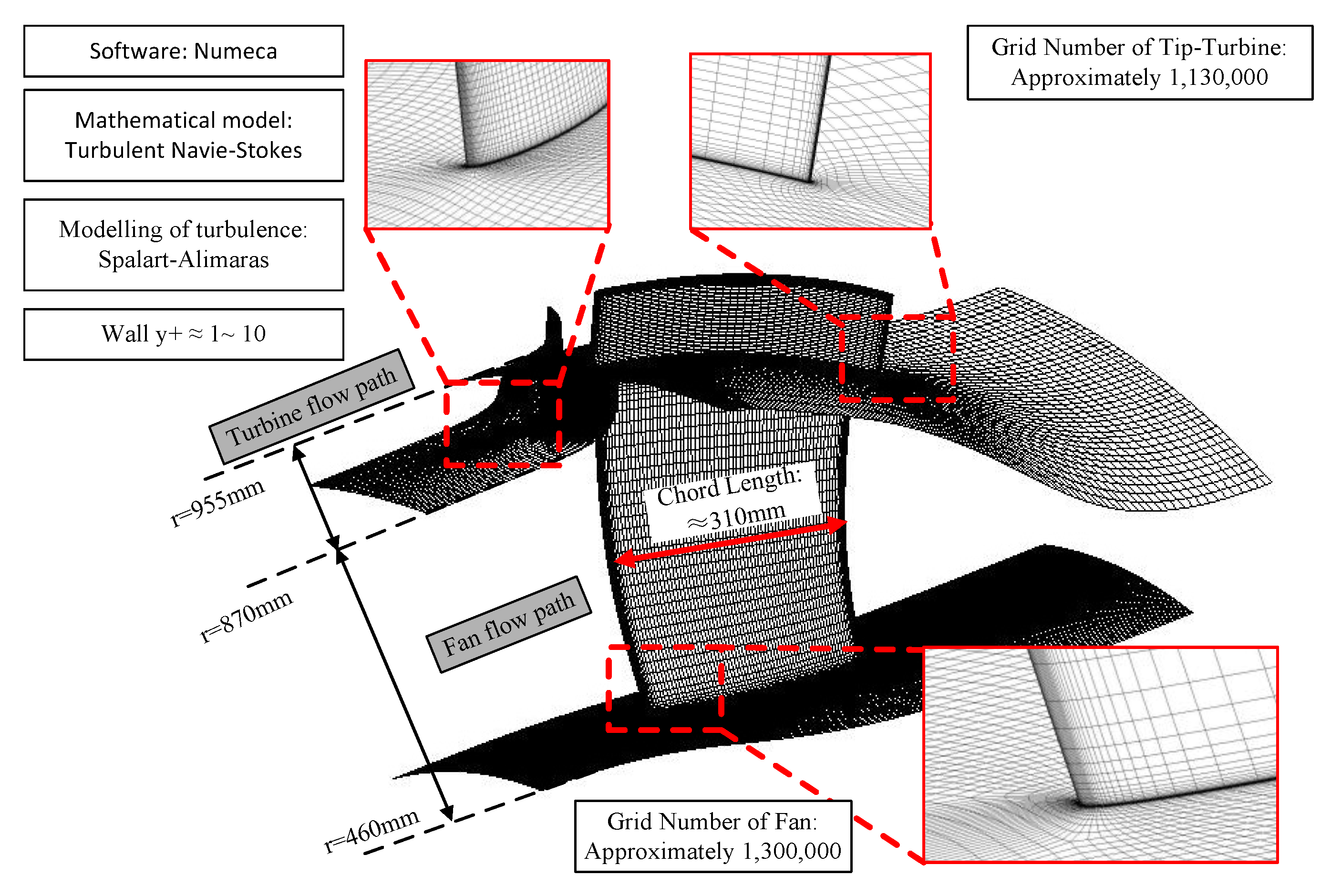
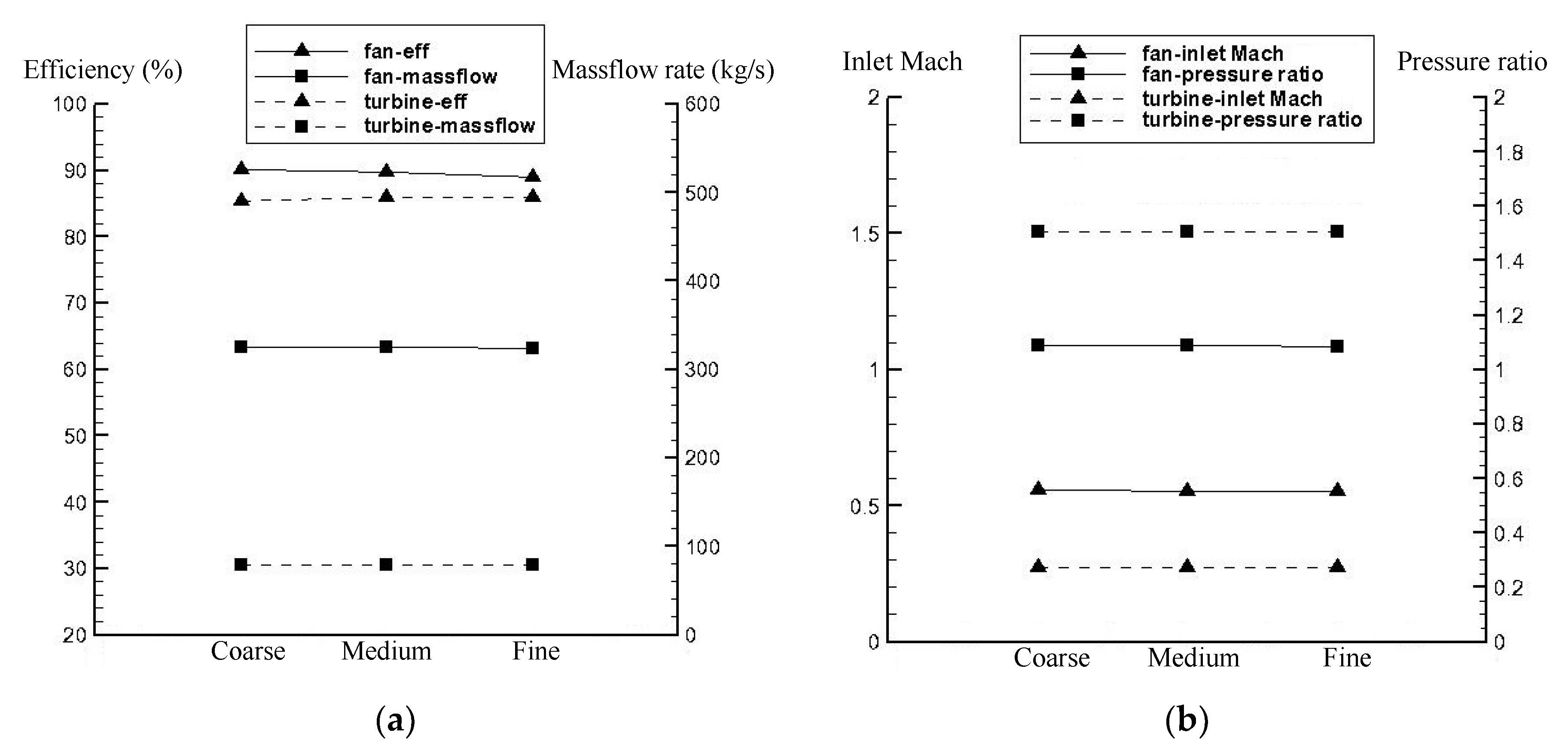
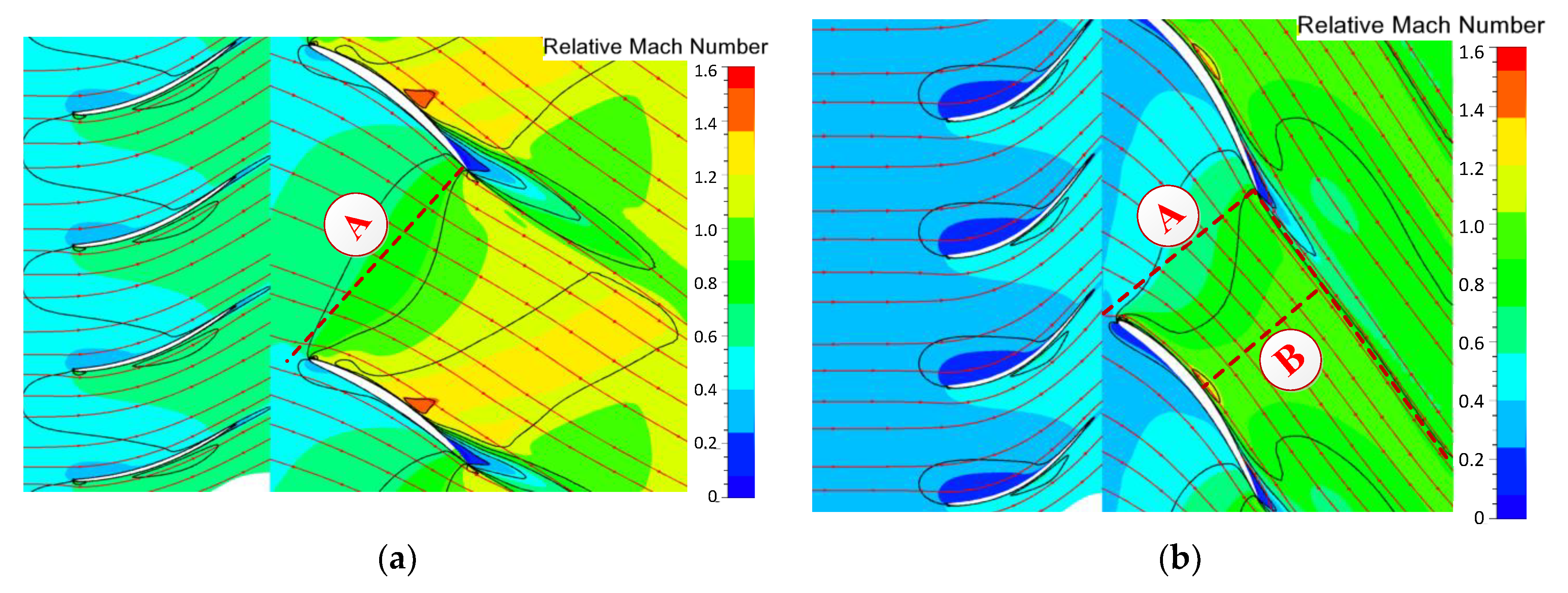
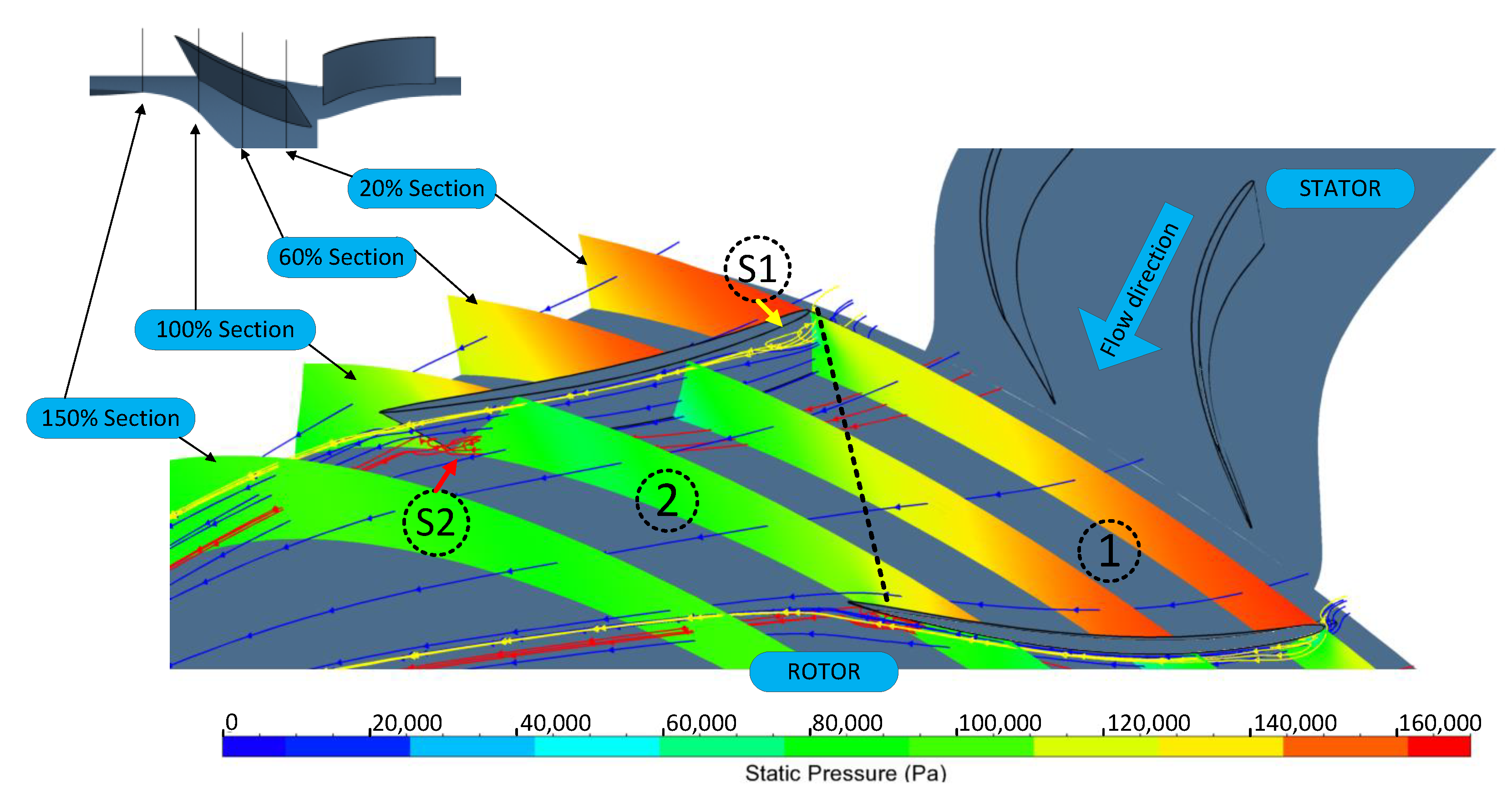
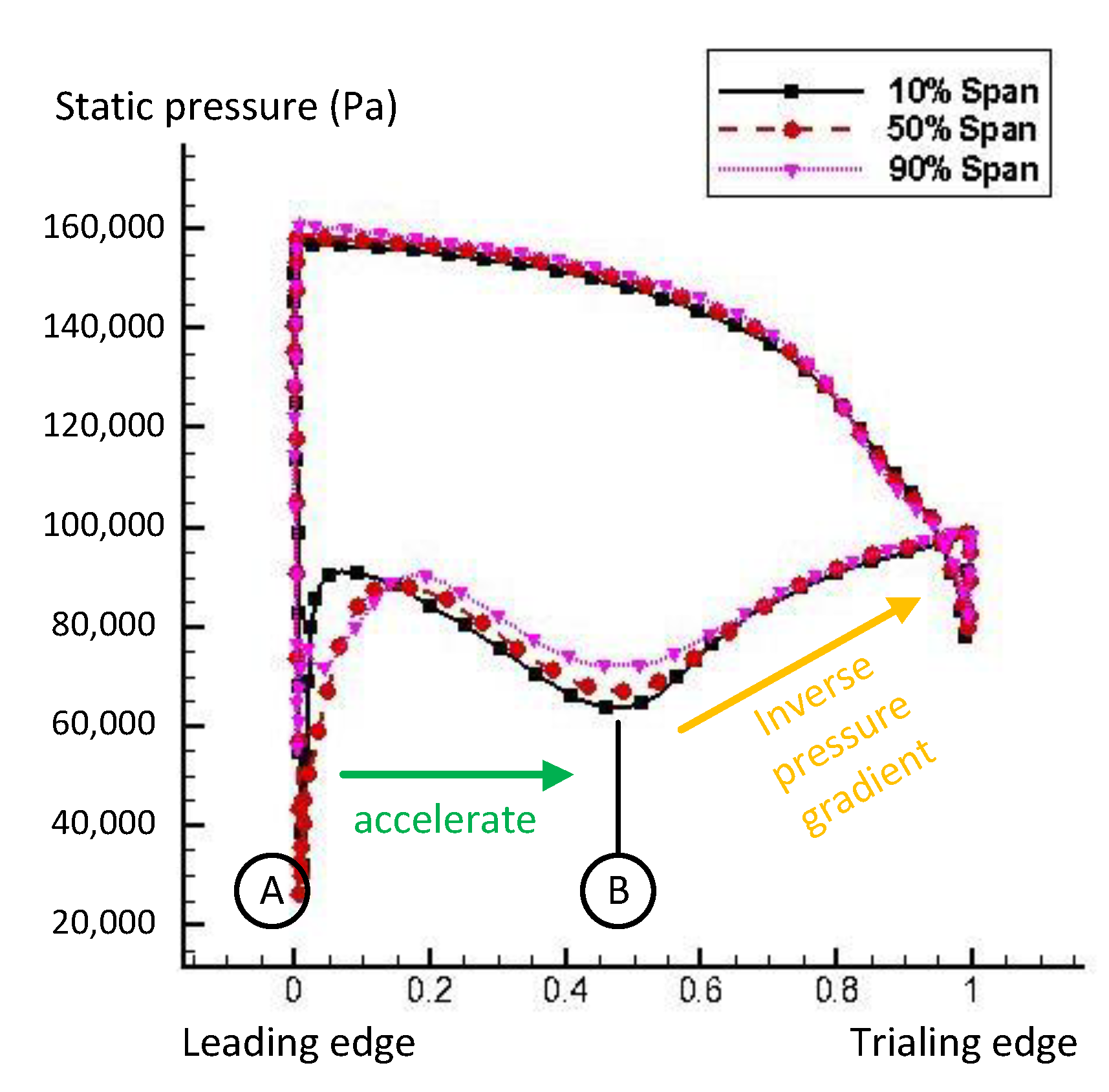
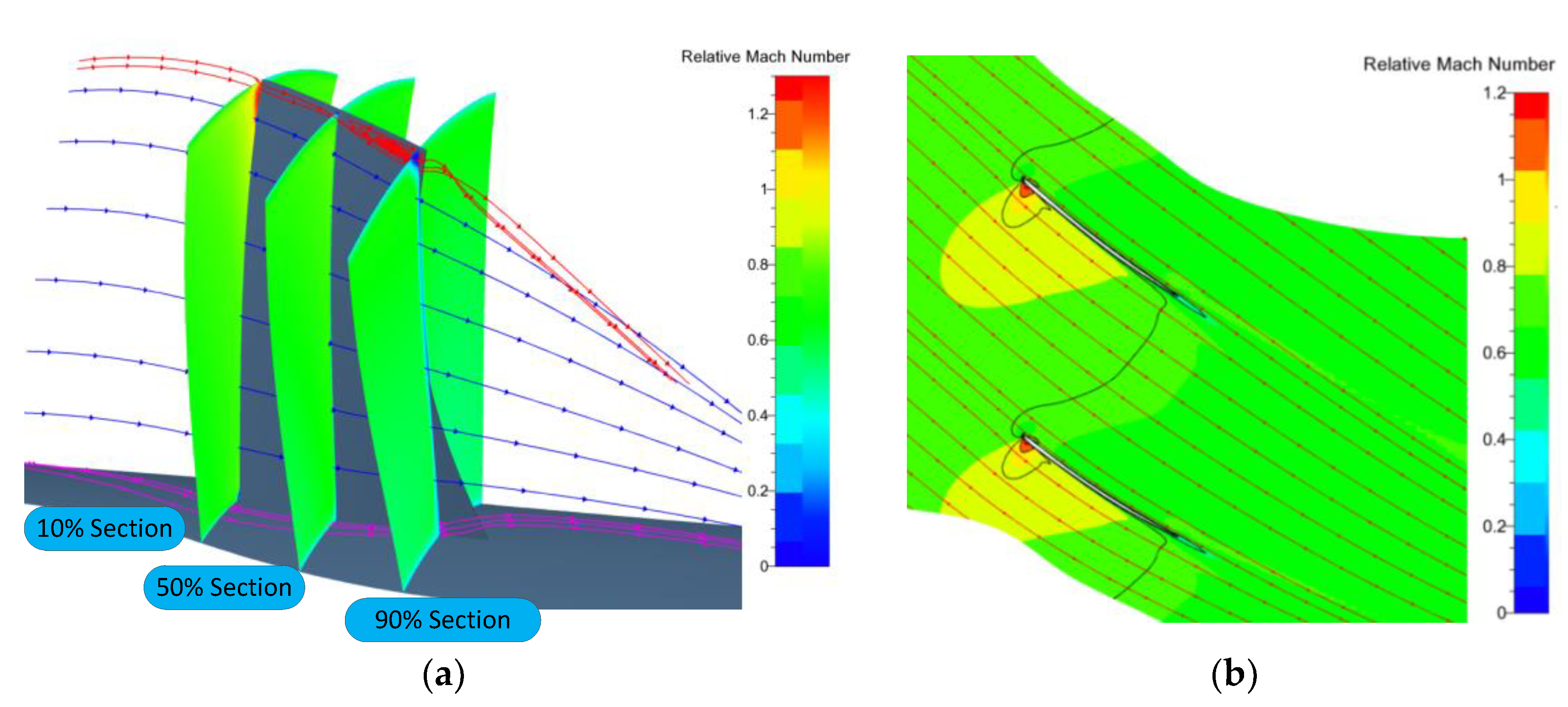
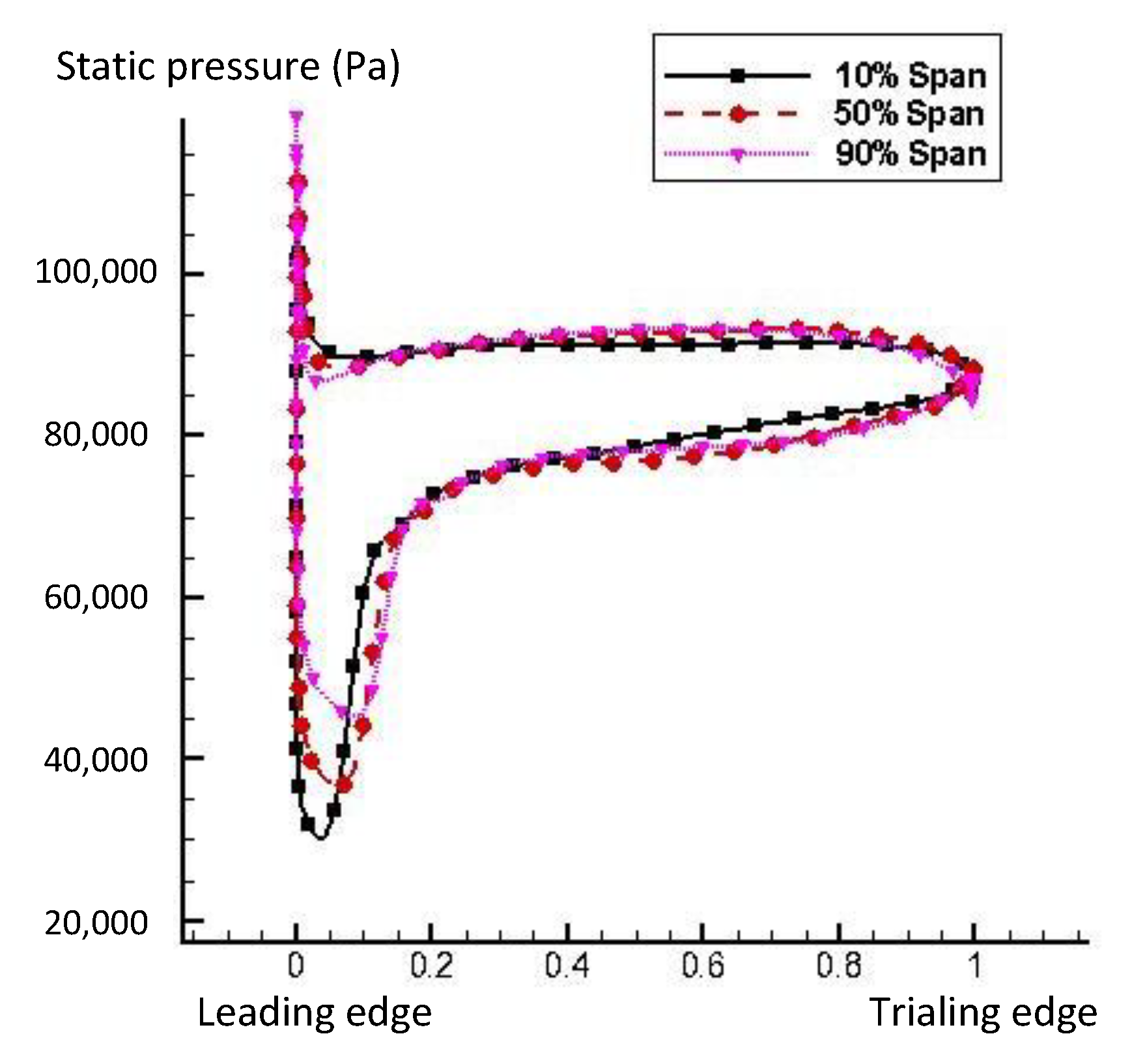
| Parameters | CFE738 | Preliminary ADFTT |
|---|---|---|
| BPR | 5.3 | 27.8 |
| pressure ratio of bypass | 1.7 | 1.085 |
| Mass flow rate (kg/s) | 95.3 | 422.0 |
| Thrust (kN) | 25.5 | 48.2 |
| - | 1.89 | |
| - | 0.96 | |
| - | 0.86 | |
| - | 0.87 | |
| - | 0.807 |
| Parameters | Fan Rotor | Tip Turbine |
|---|---|---|
| Efficiency | 89.7% | 85.9% |
| Pressure ratio (drop) | 1.09 | 1.51 |
| Mass flow rate () | 325 | 79.2 |
| Power () | −2544 | 2654 |
| Torque () | −12,151 | 12,672 |
| Parameters | Prototype Turbofan | Preliminary ADFTT | Alteration (%) |
|---|---|---|---|
| BPR | 5.3 | 27.2 | +413.0 |
| Thrust () | 25.5 | 48.5 | +84.0 |
© 2018 by the authors. Licensee MDPI, Basel, Switzerland. This article is an open access article distributed under the terms and conditions of the Creative Commons Attribution (CC BY) license (http://creativecommons.org/licenses/by/4.0/).
Share and Cite
Huang, G.; Xiang, X.; Xia, C.; Lu, W.; Li, L. Feasible Concept of an Air-Driven Fan with a Tip Turbine for a High-Bypass Propulsion System. Energies 2018, 11, 3350. https://doi.org/10.3390/en11123350
Huang G, Xiang X, Xia C, Lu W, Li L. Feasible Concept of an Air-Driven Fan with a Tip Turbine for a High-Bypass Propulsion System. Energies. 2018; 11(12):3350. https://doi.org/10.3390/en11123350
Chicago/Turabian StyleHuang, Guoping, Xin Xiang, Chen Xia, Weiyu Lu, and Lei Li. 2018. "Feasible Concept of an Air-Driven Fan with a Tip Turbine for a High-Bypass Propulsion System" Energies 11, no. 12: 3350. https://doi.org/10.3390/en11123350
APA StyleHuang, G., Xiang, X., Xia, C., Lu, W., & Li, L. (2018). Feasible Concept of an Air-Driven Fan with a Tip Turbine for a High-Bypass Propulsion System. Energies, 11(12), 3350. https://doi.org/10.3390/en11123350






